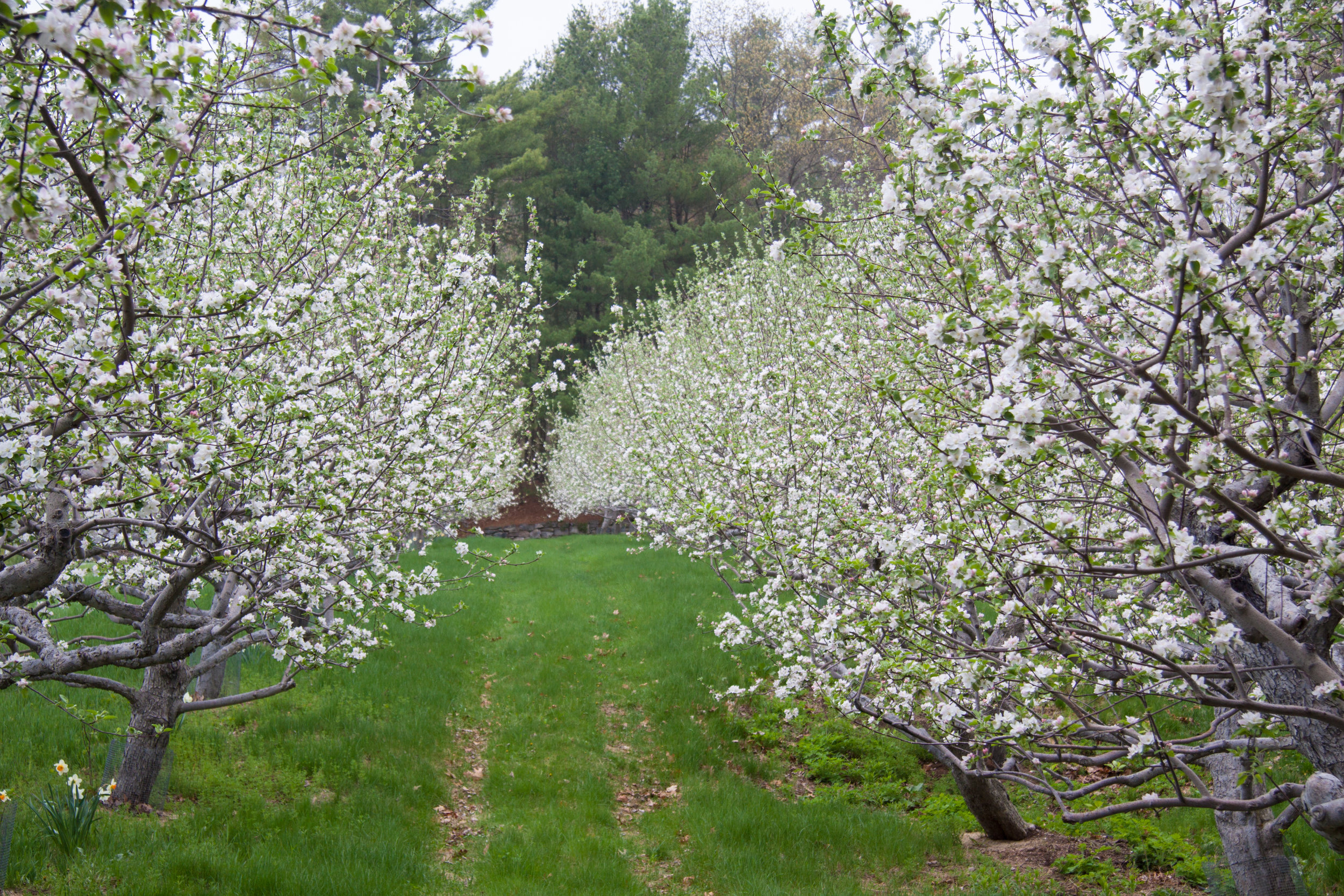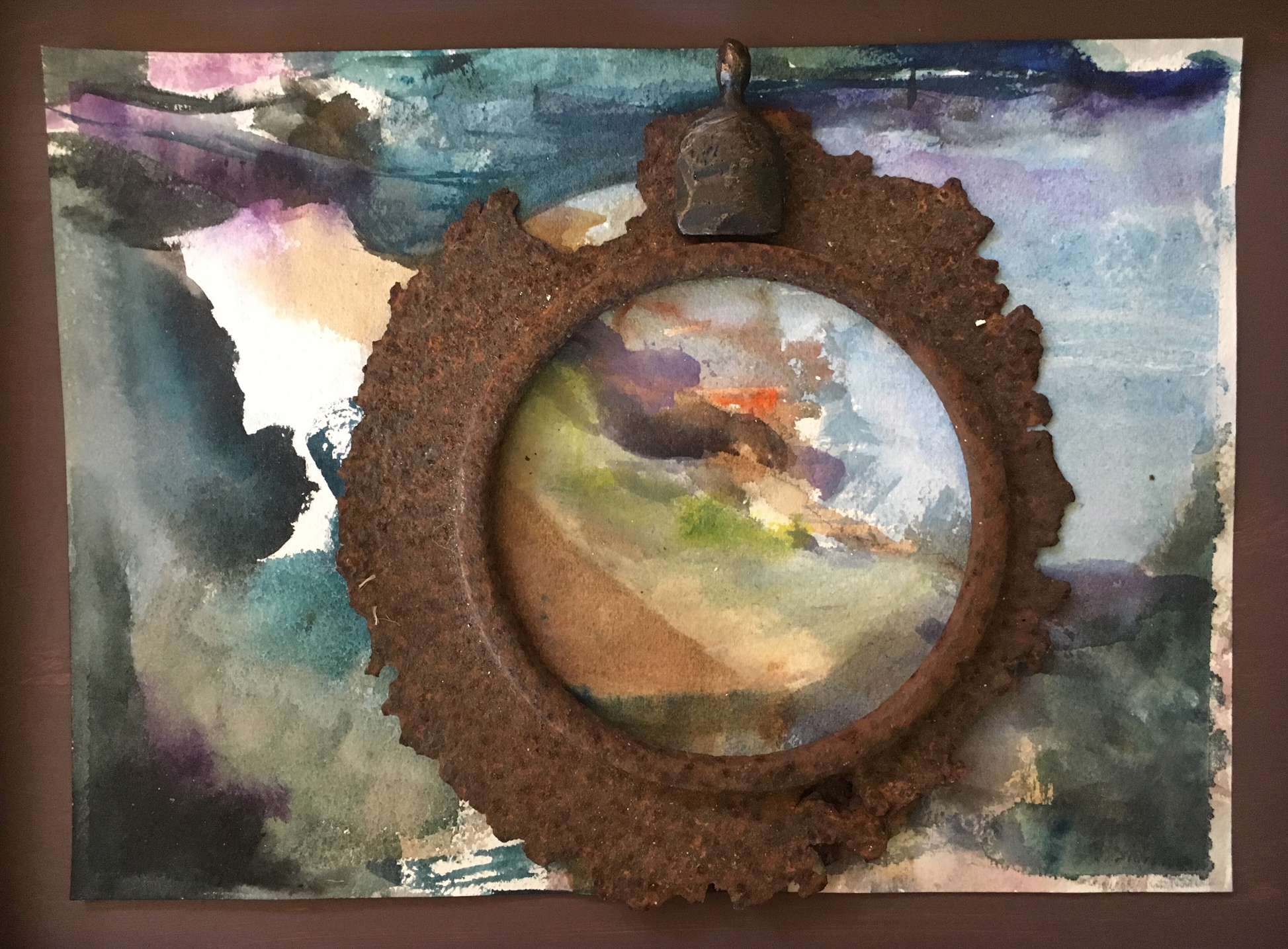It’s the question I am most often asked, and it has become my least favorite question to answer. Have you ever been in this situation? That which you most don’t want to talk about is exactly what elicits the most interest. The old Zen saying—you find your fate on the road you take to avoid it—is apropos.
No one asks, “How is your spirit, Linda?” A few ask, “How is the studio?” or about the children and about my husband, Blase. But a disproportionate number inquire, “How are the apples?” They know we’ve had some bad years.
To the apples, then. Well, maybe. . .
You see, I just don’t want to write about them. I love the trees, the land on which they grow, the wildflowers, the seasons of their lives, the bare branches in the winter, pruning, the blossoms, the buzz of pollination. In 2015, we had a magnificent bloom and gathered for apple blossom viewing with shakuhatchi music floating out from a hidden speaker in one of the trees.
Apple Blossoms Macintosh Apples
The blossoms turned to fruit, and we had a splendid crop.
But the truth is that 2015 was the last year we had a munificent harvest. In 2016, we had no fruit because of an early frost. Last fall, we had a bumper crop, but horrible scab rendered all our Macintosh and Golden Delicious apples unsellable. Out of the last four years, we’ve had one great year and one all-right year. We need to look honestly at what is happening despite the amazing 2017 Honey Crisp harvest.
My daughter, Ariel, picking Honey Crisp apples in 2017.
Growing organic apples was never part of a get-rich scheme. When I moved into the farmhouse in 2001, the abandoned orchard across the road and I shared many characteristics. I was hurt, confused, and without solid ground under my feet. The orchard grew brambles, poison ivy, but no fruit. Bringing back the orchard became an artistic as well as spiritual passion; it grew and flourished as I healed, grafting a new life.
There is a great demand for local organic apples, and the orchard proved to be economically sustainable. However, our experience in recent years is changing the equation. Blase and I are questioning the orchard’s future. With a demanding schedule of time and resources for orchard care, growing organic apples on our scale is proving to not be sustainable. It’s not emotionally supportive: It’s downright depressing.
And why aren’t there any apples this year?
Among the multitude of interrelated answers, some I know and many I don’t. Thinning is certainly one reason. Most apple orchards thin their trees with chemical thinners when the fruit is only a few millimeters in size. This reduces the number of apples, fooling the tree into thinking it needs to produce a decent crop the following year to guarantee long-term survival. We thin our small trees by hand, too much fruit will impede healthy growth, but the mature trees are simply too big and too many so they produce a copious crop one year, and a pocket-sized one the following year—biennial production. I also think last year’s wildly successful scab fungi weakened the trees. Earlier this spring we took out seventy-five old trees—fifty Macintosh, the scab magnets, and twenty-five old. undesirable, meaning unsellable, Red Delicious trees. Fluctuating weather patterns accelerated by climate change are creating new challenges for orchardists and farmers in New England. Even though we have bees, the struggles facing our native pollinators makes pollination of apples in a cold spring a concern. Bees don’t go out of their hive unless the weather is over 55 degrees and they loathe rain. In spite of this litany, except for recent deer damage, the trees are leafy and healthy. Of course they are: No stress with no crop!
But the inexorable problem remains—there is no crop once again. This orchard that has meant so much to me, fed and nourished many others for the last fifteen years, this orchard that has been my companion, my lover, and a great teacher, is not sustainable. We are caring for some four hundred trees, too many to do this work part-time and unprofessionally. If we had a small mixed orchard it would be different.
What are we going to do? Blase and I are beginning to talk about how to make some kind of change. I have friends who decided reluctantly to move out of their house once their children fledged. I have an artist friend who moved with her husband to San Miquel d’Allende, Mexico, where, because the dollar stretches further, they built a magnificent glass and stucco house and studio. But we don't want to move. We don’t want to leave the farm.
Blase and I are both creating new directions as we live the decade of our sixties. Blase is organizing community events here and working with people one on one. He’s also returning more often to his woodworking shop in Maynard and fixing up his camp on the marsh on the North shore. He still tends a large kitchen garden and he repairs every dang machine that breaks, and they all do . . . .
I work with our part-time women farmers, Holly, Julia, and Hannah three days a week. We pull invasives, pick fruit, weed, mulch, and create new planting beds. Strawberry harvest is over and blueberries are next. On the last 90 degree Friday, we netted the blueberry rows. We were so fried by the heat, I let everyone go home at 4 o’clock instead of 5, had a shower, and promptly collapsed, forgetting about my dear friend Marion Stoddart’s party (I am so sorry, Marion).
Together, we also make art! Holly made a snake with all the sticks that needed to be picked up among the wildflowers near Paul Matisse’s Olympic Bell. Julia painted the signs for Which Way? Hannah has created some of our most memorable Instagram posts.
Planning is underway for our 12th Annual Outdoor Sculpture Exhibit, and the artists will be installing their work in August. I love finding just the right location for each sculptor's work. This year, artist Anne Eder, known at the farm for her extraordinary installations of mythical creatures, will be overseeing her students from the Harvard Ceramics Studio with their own interdisciplinary sculptural installations. And my studio will be open on September 15 & 16th, part of the Bolton Harvard Open Studio. There is much work, both farm and art, to do. In some ways it is a relief not to have a big apple crop, I have more time for other projects. Yet, when I look at the photo of Ariel and the Honey Crisp apples, I cringe with disappointment—no apple-picking, no biting into juicy organic apples, no cider-making.
What is our fate? And what road am I on trying to avoid my own? It’s right in front of me—and I can only say I am grateful.
The Earth, experiment with found object, watercolor, and bronze figure, LH



